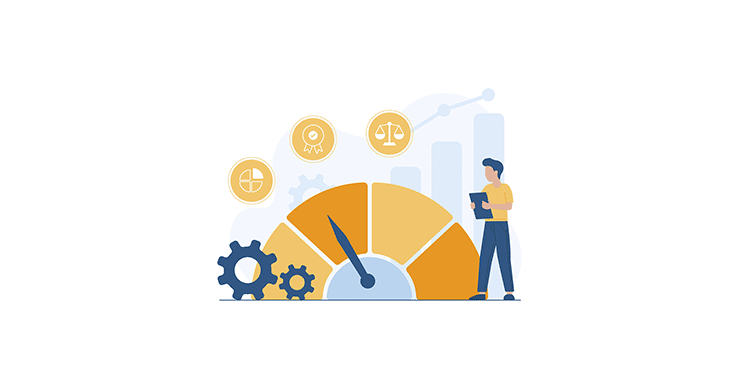Categorizing risks as high, medium, or low has been the go-to method for organizations seeking to prioritize their cybersecurity efforts. However, the ambiguity surrounding these classifications often leads to divergent interpretations, creating a significant hurdle in decision-making.
Let’s take this issue one step further.

Ten Risks in a Bed
Remember the nursery rhyme?
There were ten in the bed
And the little one said,
“Roll over! Roll over!”
So they all rolled over, and one fell out.
What happens when several risks carry the same “medium” tag, leaving decision-makers pondering where to focus their attention and allocate precious resources?
Enter the need for a more precise and actionable approach — Cyber Risk Quantification.
This blog aims to serve as a guide to navigating the intricate terrain of cyber risk quantification, providing insights into its significance, methodologies, and the transformative impact it can have on organizational cybersecurity strategies.
What is Cyber Risk Quantification?
Cyber risk quantification is the strategic process of translating IT and cyber risk exposure into tangible monetary terms. It goes beyond abstract risk rankings and employs sophisticated simulations to estimate the financial impact of potential risk events. This approach brings clarity and accuracy where qualitative cyber risk analysis falls short.
Join us as we discover how the language of risk is translated into hard numbers. We’ll explore the CRQ method and illuminate its potential for enhancing cybersecurity postures.
In implementing this approach, organizations gain the ability to answer pivotal questions such as “How much should we invest in cybersecurity?” and “What is the return on investment?” Armed with quantifiable insights, cybersecurity professionals, executive boards, and business leaders can collaboratively make informed, data-driven decisions that align cyber programs with overarching business goals.
Distinguishing First vs. Third-Party Cyber Risk
Granular risk quantification necessitates distinguishing between internal and external factors.
First-Party or Internal Risks: Looking Yourself in the Eye
Internal risks within an organization encompass a range of potential threats that can impact the integrity and security of digital assets. These risks may manifest in various forms, including:
- Infrastructure Vulnerabilities: These refer to weaknesses in the organization’s technological foundation, such as outdated software, unpatched systems, or insecure network configurations.
- Insider Threats: Employees or other individuals accessing the organization’s systems pose a potential risk, whether through intentional actions (malicious insiders) or unintentional mistakes (negligent insiders).
- Gaps in Security Protocols: Inconsistencies or inadequacies in established security measures, including weak password policies, insufficient access controls, or gaps in data encryption protocols.
Quantifying Internal Risks:
To quantify internal risks, organizations employ comprehensive risk assessment methodologies. This involves conducting vulnerability assessments, penetration testing, and analyzing historical data on security incidents. Metrics such as the number of identified vulnerabilities, the severity of these vulnerabilities, and the historical frequency of insider incidents contribute to a quantitative understanding of internal risks. This data-driven approach enables organizations to prioritize and address the most critical vulnerabilities.
Third-Party Risks: Looking Over Your Shoulder
Third-party risks arise from external entities integral to an organization’s operations. Remember that third-party security breaches affect your bottom line. These risks include:
- Supplier Risks: Risks associated with suppliers’ security practices, especially if they can access sensitive information or provide critical services.
- Service Provider Risks: External service providers, such as cloud service providers or IT outsourcing partners, introduce risks related to the security measures they implement.
- Business Partner Risks: Collaborative ventures and partnerships may expose organizations to the cybersecurity postures of their partners, impacting overall security.
Quantifying Third-Party Risks:
Quantifying third-party risks involves conducting thorough assessments of the cybersecurity practices of external entities. This can include evaluating the effectiveness of their security controls, analyzing their incident response capabilities, and assessing their compliance with industry regulations. Metrics such as the level of data access granted to third parties, the results of security audits, and the history of security incidents related to external entities contribute to the quantitative measurement of third-party risks.
The Case for Separate Assessments:
Internal risks often stem from within the organization, involving factors like employee behavior and infrastructure vulnerabilities. In contrast, third-party risks originate externally, tied to external entities’ practices and security postures.
In addition, internal risks may involve protecting proprietary data and intellectual property, requiring an understanding of the organization’s internal dynamics. Third-party risks, on the other hand, involve dependencies and compliance issues that demand a different set of considerations.
Separating first-party and third-party risk assessments and quantification enables organizations to assign specific metrics to each risk category. The distinction between internal and third-party risks is not only about recognizing their origins but also about tailoring risk quantification strategies to address the unique challenges posed by each category. This nuanced approach empowers organizations to manage and mitigate cyber risks proactively, fostering a robust and adaptive cybersecurity framework in an ever-evolving digital landscape.
Start Getting Value With
Centraleyes for Free
See for yourself how the Centraleyes platform exceeds anything an old GRC
system does and eliminates the need for manual processes and spreadsheets
to give you immediate value and run a full risk assessment in less than 30 days
Risk Quantification Methods
The market boasts various risk quantification models, each bringing its unique approach. Some notable models include:
FAIR (Factor Analysis of Information Risk) Framework:
- This model provides a structured approach to risk analysis, emphasizing factors such as frequency and magnitude of loss.
NIST (National Institute of Standards and Technology) Cybersecurity Framework:
- NIST’s framework offers comprehensive guidelines, standards, and best practices for managing cybersecurity risks.
ISO 27001:
- This international standard outlines the requirements for an information security management system (ISMS) and is widely used for risk management.
How To Quantify Risks
Step 1: Define Critical Assets through Asset Identification
Begin the process by meticulously creating an inventory of all assets within the organization. This includes tangible assets like equipment and facilities and intangible assets such as data and software. The goal is to have a comprehensive list spanning the organizational resources spectrum.
Step 2: Prioritization Criteria and Categorization
Establish clear and well-defined criteria for prioritizing assets. Consider factors such as their direct contribution to revenue, strategic importance in achieving organizational goals, and the potential impact on day-to-day operations. This step is crucial for aligning the identification of critical assets with the overarching goals and priorities of the organization.
Step 3: Establish a Risk Management Framework
Before delving into the quantification process, ensure that a robust risk management framework is in place. Define the scope, objectives, and methodologies for managing cyber risks within your organization.
Step 4: Assess Threats and Vulnerabilities
Determine potential threats facing your organization, considering both internal and external factors. Understand the motives and capabilities of potential adversaries for accurate risk quantification.
Step 5: Evaluate Controls and Safeguards
Assess the effectiveness of existing cybersecurity controls and safeguards. Evaluate these controls against industry best practices and regulatory requirements.
Step 6: Quantify the Impact and Likelihood
Define the impact and likelihood of each identified risk scenario, considering financial, operational, and reputational consequences.
Step 7: Calculate Risk Scores
Use a risk scoring model to calculate the overall risk score for each identified risk. Assign numerical values to impact and likelihood to prioritize risks based on severity.
Step 8: Prioritize and Mitigate
Prioritize risks based on their calculated scores and focus on addressing the most critical ones first. Develop mitigation strategies and action plans to reduce the impact and likelihood of high-priority risks.
Step 9: Monitor and Update
Continuously monitor your organization’s risk landscape, update risk assessments, and adjust mitigation strategies as needed. Regularly revisit and refine these steps to contribute to a resilient cybersecurity posture.
Centraleyes: Revolutionizing Cyber Risk Quantification
Quantifying Risk in Real Time
- Centraleyes introduces a revolutionary approach to cyber risk quantification through its Next-Gen proprietary automated enterprise risk register. Elaborate on features or technologies enabling Centraleyes to provide real-time risk quantification.
Customized Risk Scenario Mapping
- The platform empowers users to map and define their company’s unique risk scenarios. Provide examples of how customization in risk scenario mapping adds value to organizations.
Holistic Risk Quantification
- Centraleyes goes beyond just identifying and mapping risks; it facilitates the quantification of both inherent and residual risk. Clarify how Centraleyes achieves a holistic view of risk, and how organizations can benefit from understanding both inherent and residual risk.
Seamless Integration with Pre-Loaded Risk Assessments
- Centraleyes streamlines the risk quantification process by integrating pre-loaded risk assessments, enhancing efficiency, and ensuring that industry best practices and standards are considered.
Risk and Compliance Management Unified
- One of Centraleyes’ distinguishing features is its ability to manage risk and compliance in a unified platform. Provide examples of how the unified platform enhances overall cybersecurity governance.
Efficiency in Action
- Centraleyes’ platform is designed with efficiency in mind, reducing the administrative burden on security and compliance teams. Explore specific efficiency metrics or case studies that demonstrate the impact of Centraleyes on reducing administrative burden.
Simplifying Cyber Risk for Sustained Success
Organizations leveraging CRQ solutions gain profound insights into protecting themselves against cyber events. This ensures informed decision-making, fortified cybersecurity posture, and sustained success in the ever-evolving cybersecurity landscape. Contact Centraleyes to embark on a journey of simplifying and benefiting from cyber risk quantification.
Start Getting Value With
Centraleyes for Free
See for yourself how the Centraleyes platform exceeds anything an old GRC
system does and eliminates the need for manual processes and spreadsheets
to give you immediate value and run a full risk assessment in less than 30 days






